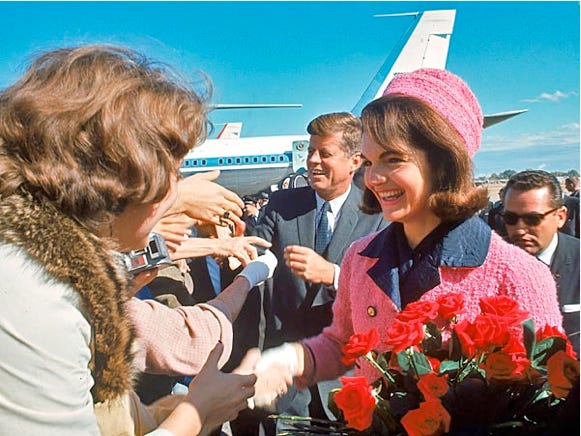
The ladies of Chez Ninon never considered Jacqueline Kennedy to be a great beauty.
She looked exquisite in photographs, they would say. She knew how to pose and how to direct her wide-set eyes. She loved French couturiers and how their designs showed off her angular figure.
She knew the colors that flattered her — and the power of a fashion statement.
That’s why the first lady ordered a raspberry-pink, double-breasted, wool bouclé suit with navy blue trim from Chez Ninon, the New York boutique run by Sophie Shonnard and Nona McAdoo Park that had dressed society ladies since 1927.
The suit was an authorized copy of a Chanel from the fall/winter 1961 collection. A receipt saved by Bill Cunningham, the famous fashion photographer who documented street style for decades and worked for Sophie and Nona in the ‘60s, shows a “fushia (sic) wool suit” was ordered for $495 on Dec. 19, 1960. That could have been the pink suit, because Sophie and Nona would have seen the Chanel collection in Paris and decided what Jackie might like.
From the archives:50 years later: Palm Beach remembers JFK as one of its own
With an eye for style sharpened by their own high-society upbringing, Sophie and Nona were among the first Americans to bring licensed reproductions from Paris to New York. Jackie’s pink suit was assumed to be a Chanel because it looked exactly like one: the pattern, fabrics, trims and buttons came directly from Chanel.
“We make all our own clothes here, some to our own design and some copied from French models,” Nona told the press in January 1962, after writer and politician Clare Boothe Luce accused Mrs. Kennedy of having a Marie-Antoinette moment and buying too many French clothes.
“Everything Mrs. Kennedy has purchased from us is made with American labor — and I think that is what is being questioned here,” Nona said. She was not about to take any criticism from Luce. After all, Nona McAdoo Park got her political smarts from her father, William G. McAdoo, who was President Woodrow Wilson’s secretary of the treasury and almost became the 1924 Democratic nominee for president. Luce was a Republican.
“Exquisitely dressed, and caked in blood”
Jackie’s pink suit became the most legendary piece of women’s clothing in American history.
She was wearing it 60 years ago, on Nov. 22, 1963, when President John F. Kennedy was assassinated in Dallas, when the entire world saw her crawl on top of the convertible they were riding in as shots rang out, and when she stood, numb and covered in her husband’s blood, as Lyndon B. Johnson was sworn in as president on Air Force One.
She refused to change out of the pink suit. “Oh, no,” she said. “I want them to see what they have done to Jack.”
Lady Bird Johnson described how the first lady looked during the swearing-in: “Her hair (was) falling in her face but (she was) very composed …Mrs. Kennedy’s dress was stained with blood. One leg was almost entirely covered with it and her right glove was caked, it was caked with blood — her husband’s blood. Somehow that was one of the most poignant sights — that immaculate woman, exquisitely dressed, and caked in blood.”
Most Americans did not know Mrs. Kennedy’s suit was pink until Life magazine published a JFK memorial issue on Nov. 29. That issue was in color, while television news and newspapers of the day were in black and white.
On July 29, 2003, Caroline Kennedy signed a deed donating the pink suit to the National Archives, with the requirement that it never be on display or used to “in any way dishonor the memory of Mrs. Kennedy or President Kennedy, or cause any grief or suffering to members of their family.” In 2103, surviving members of the family will negotiate whether the suit will ever be seen.
Chez Ninon gown now on exhibit

Other notable items in Mrs. Kennedy’s wardrobe have been on display over the years. A reproduction of a Chez Ninon gown the first lady wore to a state dinner in 1961 is on display through May at the Richard and Pat Johnson Palm Beach County History Museum in West Palm Beach.
The evening dress with yellow silk satin skirt and black silk velvet bodice was based on a 1961 Nina Ricci design and made by Chez Ninon. Mrs. Kennedy paid $323 for it in 1961, according to a receipt saved by Bill Cunningham, who recognized the historic value of everything related to the first lady.
There’s commercial value in Jackie, too. The reproduction shown in the “Endless Summer: Palm Beach Resort Wear” exhibit at the history museum features the label “Black Tie Oleg Cassini” — a 1990s mass-market manufacturer who had licensed Cassini’s name. Oleg Cassini had nothing to do with the design of this dress, original or reproduction.
More:Lilly dresses to Pucci pajamas: ‘Endless Summer’ celebrates Palm Beach’s fashion history
Cassini sold himself as Mrs. Kennedy’s “official designer,” and he is the designer most closely associated with her. But the ladies of Chez Ninon could be considered Jackie’s primary stylists. She wore both Cassini and Chez Ninon creations on her trip with JFK to Paris in 1961, and she asked Sophie and Nona to look out for her wardrobe needs when they attended the couture shows in Paris twice a year.
Jackie so trusted their taste that she had her social secretary Letitia Baldridge send White House photographer Cecil W. Stoughton to New York to photograph Chez Ninon’s Spring 1962 collection. Stoughton recalled the story in a 2002 interview:
“Tish Baldridge says, ‘You know Jackie likes the fashions and dresses and stuff. She can’t see the spring collection in New York because she’d be very upsetting to the clientele of Chez Ninon. She had planned on going. But she thought better of it. And she wants you to go and make pictures of all of the fashions.’ I flew up to New York with a camera and a suitcase full of lights. I made arrangements with the gal who ran the show to put the girls in their dresses in front of a full-length mirror, which there were plenty of, so that if I sat over to the side on an angle, I would get the front of the dress and I’d also get the reflection of the back at the same time … So I did this all day. I don’t know how many — 40, 50 dresses and ensembles.”
He put them in an album for Mrs. Kennedy, so she could ponder what she would order.
On Feb. 14, 1962, the first lady wore a red suit, perhaps because it was Valentine’s Day, for her televised tour of the White House, a CBS special that drew 80 million viewers. The simple suit with three large buttons on the left side appeared gray on TV — but it was a bright red Christian Dior, recreated by Chez Ninon and made in America.
She wore a three-strand choker of pearls and a couple of bracelets, including one that appears to be an enamel-and-gold bangle by Jean Schlumberger of Tiffany. The first lady collected so many Schlumberger bangles that they became known as the “Jackie.” Want one? They cost around $55,000 at Tiffany, but reproductions can be found for $60.
Although famed fashion editor Diana Vreeland is often given credit for discovering Schlumberger, it was Sophie and Nona who made him a big name in New York. They saw the spectacular buttons he created for Elsa Schiaparelli in Paris in the 1930s and hired him to design clothes for Chez Ninon. In 1941, the women’s pages of the New York Daily News frequently featured sketches of dresses by Schlumberger for Chez Ninon.
Schlumberger joined Tiffany in 1956, designing stunning sparklers for the same socialites dressed by Chez Ninon — plus the Duchess of Windsor, who was no friend of Nona and Sophie.
Nona had known Wallis Warfield when they were both attending debutante balls in Baltimore — and Nona refused to curtsy to Wallis when she became a duchess, Bill Cunningham said in the 2018 documentary “The Times of Bill Cunningham.”
“They thought she was brash and a social climber,” says Tim Coy, Sophie’s grandson.
The duchess did not make the International Best-Dressed List in 1940. One reason: Nona was on the judging panel.
‘It was just gaiety and fun at their apartment‘

Tim Coy’s grandfather was Edward H. “Ted” Coy, a Yale football star so famous and so handsome F. Scott Fitzgerald based a short-story character on him.
Sophie Meldrim was the most beautiful and celebrated belle in the South. Dozens of men wooed her, sending jewels and gifts to her Savannah home, now known as the “Green-Meldrim House” and notable because it was Gen. William Tecumseh Sherman’s headquarters during the Civil War.
Young Sophie even caught the eye of Willie Vanderbilt — grandson of Cornelius Vanderbilt, the railroad baron — but he bored her. “All he talked about was yachts and ports …” Sophie said in an interview shortly before her death in 1980 at age 92.
“Sophie was a lot like Scarlett O’Hara — without the duplicity,” Tim Coy says.
Dazzled by Ted Coy, an athlete and a Yankee so different from her Southern suitors, Sophie eloped with him in 1913. They had two sons, Ted Jr. and Peter, Tim Coy’s father. After their divorce in 1925, Ted Coy married famed film star Jeanne Eagels, who died of a drug overdose in 1929, in the medical office of Nona’s second husband, Dr. Edward S. Cowles, considered the first “celebrity psychiatrist.”
One needs a spreadsheet to keep track of the love lives of Sophie and Nona and their intertwined families. Sophie’s second husband was financier Horatio S. Shonnard, who divorced her on grounds of mental cruelty in 1944, and Nona was married four times. Sophie’s son Peter married Sally McAdoo, the daughter of Nona’s brother, Francis, in 1942, so Nona and Sophie became relatives.
Ultimately, their true loves were two: Paris and their partnership.
“The shop was an exclusive club where everyone knew each other,” Cunningham wrote in his book “Fashion Climbing,” published in 2018, two years after his death. “Nona’s sister-in-law, Molly McAdoo, directed the salon, and a few elegant friends down on their luck sold the clothes to more friends. The shop was an immediate success, as their formula for dressing their friends in clothes that fit their way of life was correct. Their families, though, were horrified that they had opened their shop. Their view was that young women from fine families just didn’t go into business, they weren’t educated for anything but the niceties of home and card games.”
Sophie and Nona were rare women for their class and time: elegant, funny, opinionated, independent, whip-smart. Sophie’s charm balanced Nona’s wit. Their baby, Chez Ninon, was a success for 50 years.
“We were completely opposite, but we adored each other,” Sophie said of Nona, who died in 1971 at age 78.
They lived together in a grand apartment in New York for much of their lives.

“It was just gaiety and fun at their apartment,” Tim Coy remembers. Once, when he was at Yale and came for a visit, his grandmother Sophie and his aunt Nona lamented for a moment that they had built a career in fashion instead of art or literature.
They did not give themselves the credit that history has awarded them: because of Sophie Shonnard and Nona McAdoo Park, the most stylish first lady of all time was able to wear the French styles she loved — including her unforgettable pink suit.
Jan Tuckwood is the former associate editor of The Palm Beach Post. She is writing a book on Sophie Shonnard and Nona McAdoo Park.


This post was originally published on this site be sure to check out more of their content.






